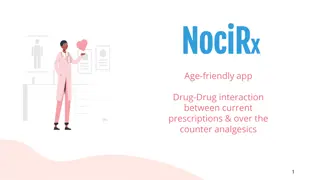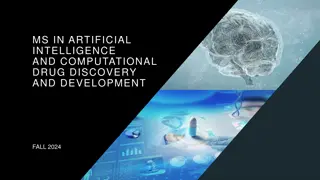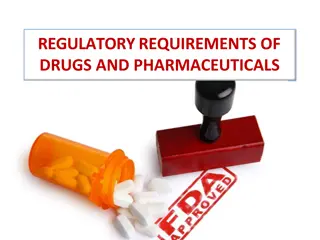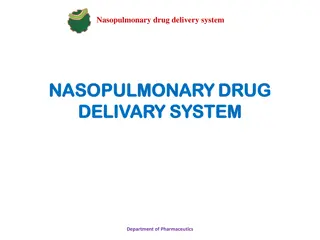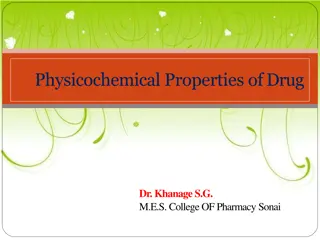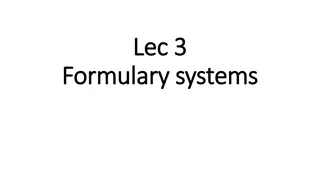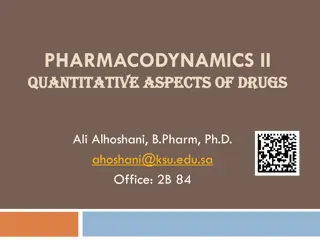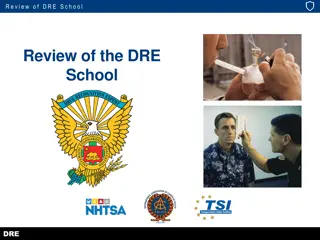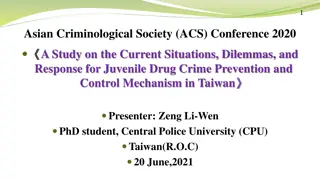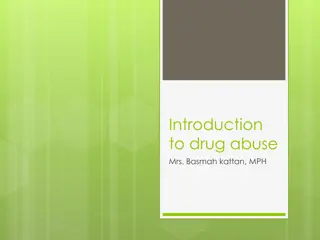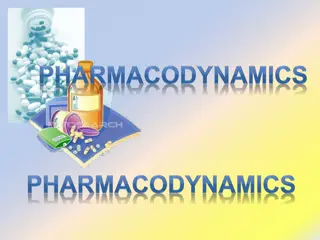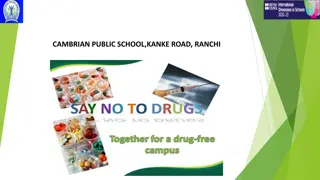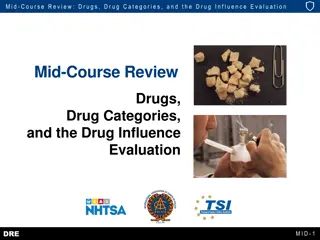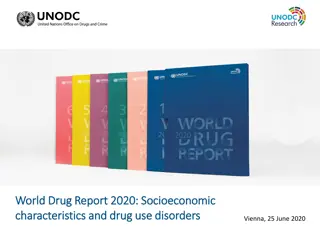
Insights into Drug Discovery Disciplines and Target Validation
Explore the crucial steps in drug discovery, from target validation to disciplines like chemistry, pharmacology, and ADME properties. Learn how Isothermal Titration Calorimetry (ITC) aids in understanding molecular interactions for therapeutic effects.
Download Presentation

Please find below an Image/Link to download the presentation.
The content on the website is provided AS IS for your information and personal use only. It may not be sold, licensed, or shared on other websites without obtaining consent from the author. If you encounter any issues during the download, it is possible that the publisher has removed the file from their server.
You are allowed to download the files provided on this website for personal or commercial use, subject to the condition that they are used lawfully. All files are the property of their respective owners.
The content on the website is provided AS IS for your information and personal use only. It may not be sold, licensed, or shared on other websites without obtaining consent from the author.
E N D
Presentation Transcript
Lecture 3 Lecture 3 4/4/2025 1
Target Validation: After a drug target has been identified, a rigorous evaluation must occur to demonstrate that modulation of the target will have the desired therapeutic effect. This involves intensive in vitro, as well as in vivo studies that provide information on the effects of biotherapeutic intervention. 4/4/2025 2
Isothermal Titration Calorimetry (ITC) can play a critical role in the determination of the mechanism of action of a specified target pathway. It is impossible to screen for unknown biotherapeutic targets, but this is where Isothermal Titration Calorimetry (ITC) can play a critical role. ITC measures the natural heat generated or absorbed in any biomolecular interaction. There is no requirement for any prior knowledge of the binding partners, substrates or other cofactors. 4/4/2025 3
* Isothermal titration calorimetry (ITC) is a physical technique used to determine the thermodynamic parameters of interactions in solution. * It is most often used to study the binding of small molecules (such as medicinal compounds) to larger macromolecules (proteins, DNA etc.). File:ITC1.png 4/4/2025 4
Disciplines in Drug Discovery A. Chemistry: The first step after identification of the target in any drug discovery process is the decision of which natural compounds or chemical structures to synthesize. There are various means by which compounds can be isolated or synthesized for biological activity testing. 4/4/2025 5
B. Pharmacology: After chemistry step, NCE is tested against a single or multiple therapeutic targets to determine if the NCE has any potential to elicit a pharmacological response. This pharmacological testing can be done in multiple different ways depending on the number of compounds to be screened, the speed at which you need to screen, the limitations of what is known about a biological target, or the reagents available to the researcher. 4/4/2025 6
C. ADME Properties: The properties of absorption, distribution, metabolism, and elimination (ADME) of potential new drugs are the disciplines of pharmacokinetics, pharmaceutics, drug metabolism, and drug transport. 4/4/2025 7
D. Pharmacogenomics: Pharmacogenomics (pharmacogenetics) is the grouping of a pharmacological drug response from a population based on the genetic variation of that population. In some instances, different individuals in a population respond to the same drug in different ways; these variations can be due to genetic variations in the biological target (receptor), genetic differences in drug transport, or the metabolizing enzymes that are involved in drug absorption and clearance. E. Toxicology: In addition to the above-mentioned properties, the potential toxicological aspects of discovery compounds should be evaluated at the earliest opportunity. 4/4/2025 8
Drug Discovery from Nature The Impact of Natural products on Drug Discovery: 4/4/2025 9
A natural product is a chemical compound or substance produced by a living organism - found in nature that usually has a pharmacological or biological activity for use in pharmaceutical drug discovery and drug design. 4/4/2025 10
Natural products may be extracted from * Tissue of terrestrial plants. * Marine organisms. * Microorganism fermentation broths. A crude (untreated) extract from any one of these sources typically contains novel, structurally diverse chemical compounds. Chemical diversity in nature is based on biological and geographical diversity, so researchers travel around the world obtaining samples to analyze and evaluate in drug discovery screens or bioassays. This effort to search for natural products is known as bio prospecting. 4/4/2025 11
Natural products have provided the inspiration for most of the active ingredients in medicines: around 80% of medicinal products up to 1996 were either directly derivedfrom naturally occurring compounds or were inspired by anatural product, and more recent analysis confirms thecontinuing importance of natural products for drug discovery. 4/4/2025 12
Plants have formed the basis of sophisticated traditional medicine systems that have been in existence for thousands of years, and their uses by many cultures have been extensively documented. These plant-based systems continue to play an essential role in healthcare, and it has been estimated by the World Health Organization that approximately 80% of the world s inhabitants rely mainly on traditional medicines for their primary health care. 4/4/2025 13
Drugs derived from natural products launched in Europe, Japan and the United States 20012005. Year 2001 Telithromycin (Ketek1) 2002 Amrubicin hydrochloride (Calsed1) 2002 Biapenem (Omegacin1) 2002 Ertapenem (InvanzTM) 2002 Fulvestrant (Faslodex1) 2002 Galantamine (Reminyl1) 2002 Nitisinone (Orfadin1) 2003 Pitavastatin (Livalo1) 2003 Rosuvastatin (Crestor1) 2004 Everolimus (CerticanTM) 2004 Talaporfin sodium (Laserphyrin1) 2005 Paclitaxel nanoparticles (Abraxane1) 2005 Pramlintide acetate (Symlin1) 2005 Tigecycline (Tigacil1) 2005 Zicontide (PrialtTM) Generic name (trade name) Natural product Erythromycin Doxorubicin Thienamycin Thienamycin Estradiol Galantamine Leptospermone Mevastatin Mevastatin Sirolimus Chlorophyll and L-aspartic acid Taxol Amylin Tetracycline MVIIA Indications Antibacterial Anticancer Antibacterial Antibacterial Anticancer Alzheimer s disease Antityrosinaemia Dyslipidemia Dyslipidemia Immunosuppression Anticancer Anticancer Anti-diabetic Antibacterial Pain management Cited from Kin S. Lam (2007).New aspects of natural products in drug discovery.TRENDS in Microbiology Vol.15 No.6. 279-289. 4/4/2025 14
Natural products can be obtained from different sources such as: 1-The plant kingdom: It is rich source of lead compounds (e.g. morphine, cocaine, quinine, tubocurarine, nicotine and muscarine, paclitaxel (Taxol, anticancer), either useful drugs as morphine or basis for synthetic). Plants continue to remain a promising source of new drugs. 2-The microbial world: microorganisms such as bacteria and fungi are rich for lead compounds (e.g. pencillins, cephalosporines, tetracyclines, aminoglycosides, chloramphenicol, rifamycins). 4/4/2025 15
3-The marine world: coral, sponges, fish and marine microorganisms have biological potent chemicals, with interesting, anti-inflammatory, antiviral, and anticancer activity. E.g Curacin A (anti-tumour, from marine cyanobacterium) 4-Animal sources: antibiotic peptides were extracted from the skin ofAfrican clawed frog. Epibatidine (potent Analgasic) was also obtained from Ecuadorian frog.
Combinatorial chemistry: The use of a small set of chemical building blocks, combined together in multiple ways using standard chemistries, to create large libraries of compounds that may be screened for potential new drugs. Genomics: Establishes the relationship between gene activity and particular diseases. 4/4/2025 17

